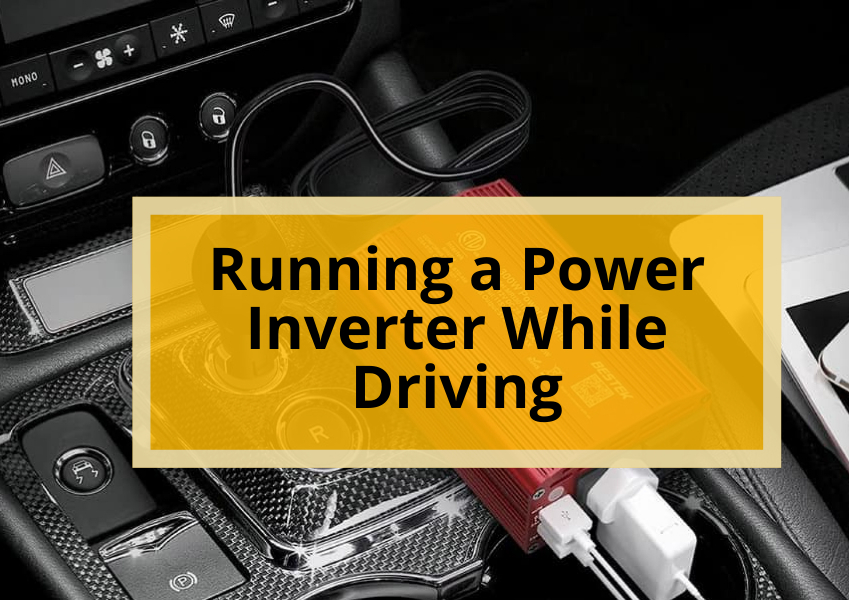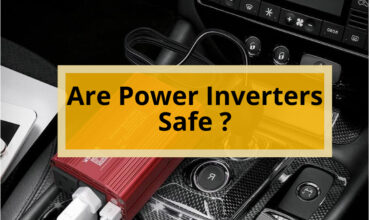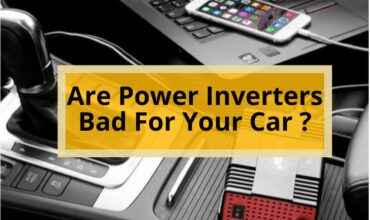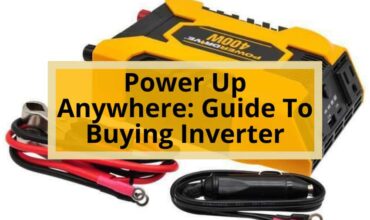Using power inverters in your vehicle can be incredibly convenient. They allow you to plug in and power various electronics and appliances, giving you access to things like laptops, phones, small TVs, and even mini-fridges while on the go.
However, there are some important factors to consider when running a power inverter in your car, especially safety-related ones. This comprehensive guide will cover everything you need to know about safely and effectively using a power inverter while driving.
What is a Power Inverter?
A power inverter is a device that converts direct current (DC) power from your vehicle’s battery to alternating current (AC) power that can be used to run electronics designed for standard wall outlets. The converted AC electricity mimics household power, just like what you get from a wall outlet at home. This allows you to power devices that you’d normally plug into an outlet in your home when you’re on the road.
Power inverters come in different capacities ranging from about 100 watts to 4000 watts or more. The wattage required depends on the types of devices you need to run. For smaller electronics like phones, tablets, or laptops, a low 100-200 watt inverter should suffice. Running larger devices or appliances will require an inverter with a higher wattage.
Also read: Power Up Anywhere: Guide To Buying Inverter
Benefits of Using a Power Inverter in Your Vehicle
- Charge laptops, tablets, phones, and other portable electronics on the go
- Power small TVs for entertainment during road trips or tailgating
- Run small power tools like drills or saws for mobile work.
- Plug in small medical devices as needed during travel.
- Power a minifridge to keep food and drinks cool while driving
- Use heated travel mugs and small appliances with standard plugs.
- Enjoy the conveniences of electricity anywhere when off the grid.
Is it Safe to Use a Power Inverter While Driving?
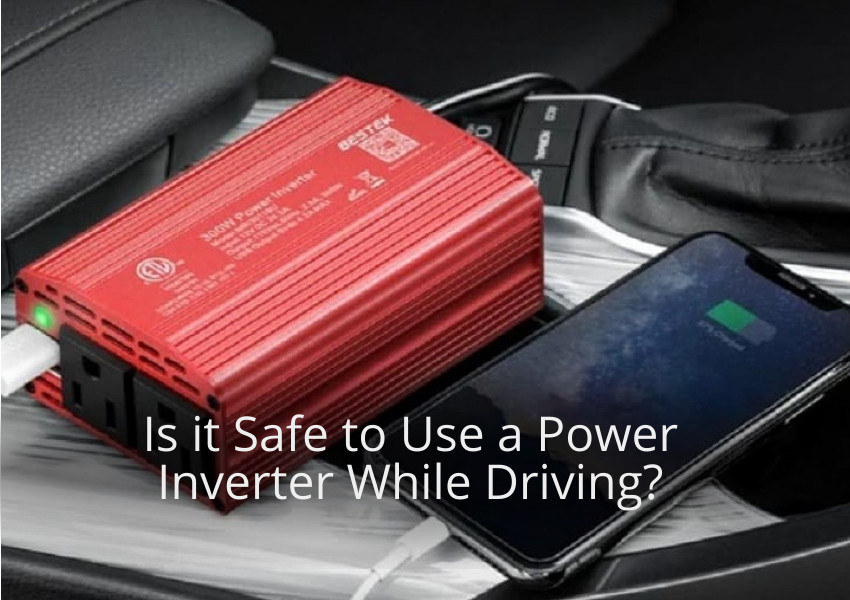
Using an inverter while driving is generally safe as long as it is done properly. The key factor in running a power inverter safely in a moving vehicle is ensuring the inverter is firmly secured in place.
An inverter that shifts around while driving can be dangerous, posing a collision hazard to the driver and passengers. Proper mounting and careful driving are essential.
Here are some key tips for using your inverter safely while driving:
- Mount the inverter securely using screws or high-quality velcro. Do not allow it to hang loosely.
- Avoid sudden braking or swerving movements that could cause the inverter to become a projectile.
- Place the inverter away from the driver’s space for maximum safety. Never let cords run across driving areas.
- Pay attention to any cords running from the inverter to avoid tangled feet or tripping while driving.
- Use heavy-duty extension cords specifically designed for power inverters. Avoid loose, worn, or weak cords.
- Keep an eye on the wattage drawn by connected devices to avoid overheating the inverter or wires.
- Do not use damaged or malfunctioning inverters in a moving vehicle under any circumstances.
Following basic precautions will allow you to run your inverter safely. Always prioritize safety over convenience when powered up on the go.
Also read: Power Up Your Electronics With Inverters
Selecting the Right Power Inverter
Choosing the right inverter for use in a car, truck, or RV comes down to three key factors:
– Intended use/devices to power
Consider the wattage needs of your devices. Inverter capacity is specified in watts. Look for sufficient wattage for simultaneous use.
– Power source
Size the inverter for your vehicle’s electrical system. Most plug into a 12V DC lighter outlet. Larger inverters may need to connect directly to the battery.
– Quality and durability
Look for stable, secure mounting and cords thermal and surge protection. Avoid cheap units with weak construction.
Here are the most common types of vehicle inverters:
– Small “cigarette lighter” style inverters that plug into accessory sockets.
These typically range from about 100 to 300 watts. Useful for powering smartphones, tablets, or laptops.
– Medium-powered inverters that connect to a vehicle’s battery using large gauge wires.
Often supply 400 to 1000 watts. Good for powering small TVs, game consoles, mini-fridges or tailgating essentials.
– Heavy-duty pure or modified sine wave inverters that connect directly to batteries with very large cables.
Use for high-drain devices like power tools or medical equipment. Often supply 2000+ watts.
– Hardwired inverter and battery systems installed as permanent vehicle features, popular for RVs and motorhomes.
It allows you to plug in anywhere.
Consider max wattage needs, ease of use, SIZE and noise level based on your planned application. Read product specs and reviews carefully before purchasing.
Connecting and Operating Your Inverter Safely
Once you’ve chosen the right power inverter for your vehicle and intended devices, follow these steps for safe setup and operation:
- Select a secure, out-of-the-way mounting location away from driver space. Do not place it loose.
- Mount the inverter very firmly using provided screws or high-quality velcro. No movement should occur when driving.
- Try to minimize the cord length between the inverter and the device. Use thick, heavy-duty extension cords marketed for inverter use if needed.
- Avoid running cords across driving paths or foot spaces. Use provided cord management features.
- Limit maximum extension cords to 10-15 feet to reduce fire and electrocution risk.
- Always start the vehicle before turning the inverter on to avoid battery drain. Shut off the inverter before turning off the vehicle.
- Do not exceed the recommended wattage capacity of your inverter. Monitor wattage use.
- Unplug devices and turn off the inverter when not in use to save battery power.
- Never recharge a dead battery using only a power inverter while driving.
- Avoid excessive braking, acceleration or turns with a powered inverter to reduce collision risk.
Following basic safety precautions will allow you to enjoy the convenience and productivity of having electricity on the go without risks.
Also read: Power Up Your TV: Inverter Tips For Efficient Energy Use
What to Watch Out For When Using a Power Inverter in Your Vehicle
While highly convenient, vehicle inverters do come with some potential downsides to be aware of, especially related to power:
Excessive Battery Drain
Running an inverter can drain your battery rapidly if not used cautiously, leaving you stranded with a dead battery. Monitor power draw and disconnect the inverter when not needed.
Overheating
Poorly ventilated inverters may overheat from high power draw. Allow adequate airflow, and do not cover. Shut down if it is excessively hot.
Short Circuits
Faulty cords and loose connections can cause dangerous shorts. Use quality cords and watch for damaged wires.
Voltage Irregularities
Inconsistent power flow can damage devices. Higher capacity pure or modified sine wave inverters provide clean, stable power.
Interference
Some inverters may cause radio or device interference. Newer models have improved shielding. Consider a hardwired power system for RVs to reduce interference.
If you experience any electrical issues, shut off your inverter immediately. Consult an expert to address problems with your inverter or vehicle electrical system.
Top Safety Tips for Running a Power Inverter While Driving
To summarize, follow these top tips for staying safe when using a power inverter on the road:
- Securely mount the inverter in a fixed, stable location out of the way inside your vehicle. Do not allow any loose movement.
- Limit cord length as much as possible. Use heavy-duty extension cords designed specifically for power inverters if needed.
- Take care to avoid tripping hazards from cords running to devices. Secure using the provided cord management features.
- Double-check electrical connections to ensure outlets and plugs are inserted fully before use. Faulty connections can cause issues.
- Turn the vehicle on before using the inverter. Shut the inverter off before turning off the vehicle to avoid battery drain.
- Monitor wattage demands. Do not allow devices to exceed the inverter’s rated wattage capacity.
- Allow adequate ventilation around the inverter to prevent overheating. Do not cover or enclose.
- Drive cautiously and avoid sudden acceleration or braking to reduce collision risk from a loose inverter or cords.
- Never try to jump-start a dead battery using a power inverter. Remove the inverter if attempting to jump-start the vehicle.
FAQ
Where should I mount the inverter in my car?
Mount the inverter securely in an out-of-the-way location away from the driver’s space. The back of an SUV, a trunk, or a rear floorboard are often good spots.
Do I need special cords for an inverter?
It’s best to use heavy-duty extension cords designed specifically for power inverters. This reduces fire and electrocution risk from excessive power draw.
How do I know if my inverter is overheating?
If the inverter feels hot to the touch, turns off unexpectedly or shows error lights, it may be overheating. Improve ventilation or reduce power draw to prevent overheating.
Can an inverter interfere with my car’s radio or electronics?
Some inverters may cause interference, especially cheaper models. Newer inverters often have improved shielding. Hardwired RV systems minimize interference.
Conclusion
Following basic safety recommendations will allow you to avoid electrical hazards and use your inverter conveniently while on the road. Drive safely and enjoy the benefits of powered electronics anywhere.
